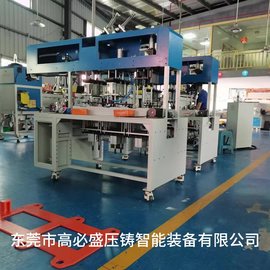东莞市高必盛压铸智能装备有限公司、20出口版GS-R01机械参数
工业机器人的包装拉伸膜包裹或+木箱
重量:200kgs
外观尺寸:80*80*150cm
气压:5-6.5kgf/cm2
关节:六个关节
轴数:六轴
工作半径:150cm
安装模式:立式固定式
抓手负载:1-10kgs
驱动:伺服驱动
抓手:夹板、手指、吸盘、或其他种类抓手
高必盛GS-R01六轴机器人的机械优点
1、有很高的自由度,6 轴,适合于几乎任何轨迹或角度的工作。
2、可以自由编程,完成全自动化的工作提高生产效率,可控制的错误率。
3、功能特性,操作非常简便,可实现不同工件之间的灵活快捷更换。
4、具有很高的可达性,可以使其手部进入封闭空间内作业,而直角坐标式机器人不能进行此类作业。
5、代替很多不适合人力完成、有害身体健康的复杂工作。
GS-R01六轴机器人缺点
1、价格高,导致初期投资的成本高。
2、生产前的大量准备工作,比如,编程和计算机模拟过程的时间耗费长。
3、肘关节和肩关节轴线是平行的,当大、小臂舒展成一直线时,虽能抵达很远的工作点,但机器人的结构刚度比较低.
常见的六轴关节机器人内置有六个伺服电机,直接通过减速器、同步带轮等驱动六个关节轴的旋转。
六轴工业机器人一般有 6 个自由度,包含旋转(S 轴),下臂(L 轴)、上臂(U 轴)、手腕旋转(R 轴)、手腕摆动(B 轴)和手腕回转(T 轴);6 个关节合成实现末端的 6 自由度动作,具有高灵活性、超大负载、高定位精度等众多优点。
六轴关节式机器人可用于自动装配、喷漆、搬运、焊接及后处理等工作,使用一直线轴重新定位,可以做出灵活得像人类一样的动作,机器人可以执行操作人员的指令。
六轴的作用
第一轴:第一轴是链接底盘的位置,也是承重和核心位置,它承载着整个机器人的重量和机器人左右水平的大幅度摆动。
第二轴:控制机器人前后摆动、伸缩的重要一轴。
第三轴:三轴也是控制机器人前后摆动的一轴,不过摆动幅度比第二轴要小很多,不过这也是六轴机器人臂展长的根据。
第四轴:四轴是控制上臂部分 180°自由旋转的一轴,相当于人的小臂。
第五轴:第五轴很重要,当你差不多调好位置后,你得精准定位到产品上,就要用到第五轴,相当于人手腕部分。
第六轴:当您将第五轴定位到产品上之后,需要一些微小的改动,就需要用到第六轴,第六轴相当于可以水平 360°旋转的一个转盘。可以更精确定位到产品。
抓手:夹板、手指、吸盘、或其他种类抓手。
Gaobisheng 20 Export Version GS-R01 Mechanical Parameters
Packaging of industrial robots wrapped in stretch film or in wooden boxes
Weight: 200kgs
Appearance size: 80 * 80 * 150cm
Air pressure: 5-6.5kgf/cm2
Joints: Six joints
Number of axles: Six axles
Working radius: 150cm
Installation mode: vertical fixed type
Grab load: 1-10kgs
Drive: servo drive
Grips: Grips, fingers, suction cups, or other types of grippers
Mechanical advantages of Gaobisheng GS-R01 six axis robot
1. Has high degrees of freedom, 6-axis, suitable for almost any trajectory or angle of work.
2. Can freely program, complete fully automated work, improve production efficiency, and control error rates.
3. Functional characteristics, very easy to operate, and can achieve flexible and fast replacement between different workpieces.
4. It has high essibility and can allow its hands to enter enclosed spaces for operations, while Cartesian robots cannot perform such operations.
5. Replace many complex tasks that are not suitable for human labor and harmful to physical health.
Disadvantages of GS-R01 Six Axis Robot
1. The high price leads to high initial investment costs.
2. The extensive preparation work before production, such as programming and computer simulation processes, takes a long time.
3. The axis of the elbow joint and the Shoulder joint are parallel. When the big and small arms stretch into a straight line, the robot can reach a far working point, but the structural stiffness of the robot is relatively low
A common six axis joint robot has six built-in servo motors that directly drive the rotation of the six joint axes through reducers, synchronous pulleys, etc.
Six axis industrial robots generally have 6 degrees of freedom, including rotation (S-axis), lower arm (L-axis), upper arm (U-axis), wrist rotation (R-axis), wrist swing (B-axis), and wrist rotation (T-axis); Six joints are synthesized to achieve 6-degree of freedom movements at the end, which has many advantages such as high flexibility, super large load, and high positioning uracy.
The six axis articulated robot can be used for automatic assembly, painting, transportation, welding, and post-processing work. It uses a linear axis to reposition and can make flexible movements like humans. The robot can execute the instructions of the operator.
The Role of Six Axes
First axis: The first axis is the position where the chassis is connected, which is also the load-bearing and core position. It carries the weight of the entire robot and the large horizontal swing of the robot from left to right.
Second axis: An important axis for controlling the robot's forward and backward swing and expansion.
Third axis: The third axis is also the axis that controls the robot's forward and backward swing, but the swing amplitude is much smaller than the second axis, but this is also the basis for the extension of the six axis robot arm.
Fourth axis: The fourth axis is an axis that controls the 180 ° free rotation of the upper arm, equivalent to a human forearm.
Fifth axis: The fifth axis is very important. After you have almost adjusted the position, you need to urately position it on the product, which is equivalent to the wrist part of a person.
Sixth axis: After positioning the fifth axis on the product, if you need some minor changes, you will need to use the sixth axis, which is equivalent to being horizontal
相关视频














